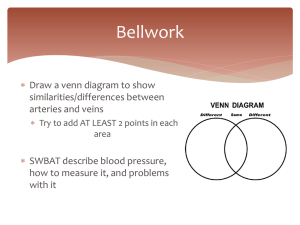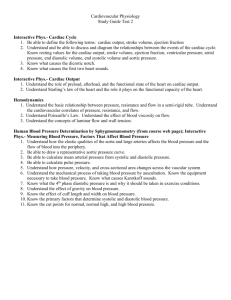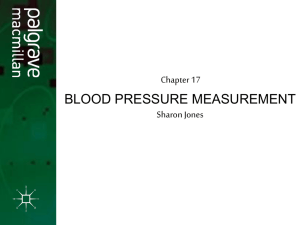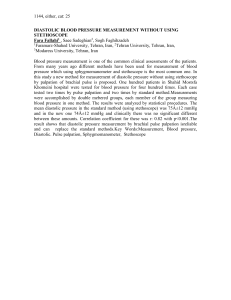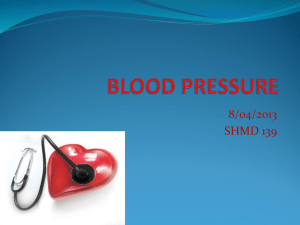Stroke volume
advertisement
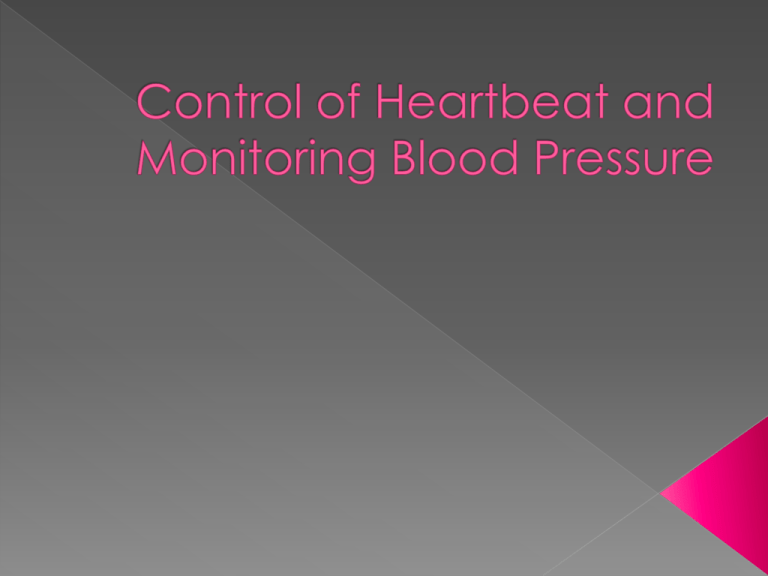
Define heart rate, stroke volume & cardiac output List the main factors affecting blood pressure Measure & accurately record heart rate & blood pressure, using equipment safely On your mini whiteboards, summarise what you remember about this! Challenge: can you write these as numeric equations? Heart rate = # beats Heart rate: number of heartbeats per minute minute 3) Stroke volume: volume of blood (cm 3 Stroke Volume = blood cm pumped by heart in 1 beat beat Cardiac output: stroke multiplied by X # beats Cardiac Output = blood cm3volume = blood the heart rate gives of blood beatthe amount minute minute (cm3) pumped by heart in 1 minute Can be changed by a number of factors: › Cardiovascular centre in brain › Hormones e.g. adrenaline › Stretching of cardiac muscle Parasympathetic & sympathetic nerves to smooth muscle of arterioles Get out your calculators! Heart rate (beats/min) Stroke Volume (cm3/beat) At rest 75 75 During exercise 180 120 Cardiac Output (cm3/min) 5,625 21,600 Blood needs to flow through vessels at a certain pressure. If pressure is too low, exchange of nutrients and gases within the tissues will not happen efficiently. This is why blood pressure is a vital measurement taken by doctors and nurses. Blood pressure is measured using a sphygmomanometer and is recorded in mmHg (millimetres of mercury) Measured in blood vessels (artery) Determined by cardiac output and resistance to flow of blood in vessels Resistance to flow affected by diameter of blood vessels Narrower vessels (vasoconstriction) Wider vessels (vasodilation) Cardiovascular centre › Diameter of blood vessels controlled by stimulation of sympathetic and parasympathetic nerves Smoking › Nicotine causes vasoconstriction › Build up of fatty deposits in vessels Diet › High fat diet leads to build up of fatty deposits in blood vessels Adrenaline › Causes selective vasoconstriction & vasodilation Increase in blood viscosity › Excess water loss (sweating/excessive urination) Get out your mini-whiteboards Write down the meanings of the words ‘systolic’ and ‘diastolic’. Compare your answers with the others on your table. Systolic blood pressure: › Maximum blood pressure › Occurs when ventricles are contracting (at the end of the cardiac cycle) Diastolic blood pressure: › Minimum blood pressure › Occurs when ventricles are relaxed and filled with blood (at the beginning of the cardiac cycle) We record blood pressure as: Systolic BP/Diastolic BP › e.g. 120/80 mm Hg Diastolic pressure gives clearest indication of resistance to flow in blood vessels Rough estimate of systolic BP is your age +100 Sphygmomanometer 1. Place the stethoscope ear pieces around your neck and wrap the cuff of your sphygmomanometer tightly around your upper arm. 2. Locate the pulse of your brachial artery by tracing your finger down your bicep down toward the crook, or inside elbow, of your arm. You should find the brachial pulse about an inch or so above this crook. 3. Put the ear pieces of the stethoscope into your ears and place the round, metal end of the stethoscope over the pulse of your brachial artery. 4. Tighten the stopcock on the sphygmomanometer bulb and squeeze the bulb of your sphygmomanometer multiple times to inflate the cuff around your upper arm. The cuff should be inflated until you've reached 180 mm of pressure. You will be able to determine how much pressure you've pumped into the sphygmomanometer cuff by reading the blood-pressure meter in front of you. 5. Release the bulb stopcock slowly and gradually. This will let the air out of the cuff, allowing you to make a blood pressure reading. 6. Note the number on the meter when you first hear your pulse through the stethoscope. Then note the number when the last pulse sound comes through the stethoscope. Record these two numbers by placing the higher number over the lower number to determine your current blood pressure. Carotid artery Radial artery Watch the demonstration of how to use the sphygmomanometer In your book, record: › Your blood pressure three times and average the results › Your heart rate three times and average the results A person’s blood pressure should be measured when they are resting and relaxed. Explain why. 2) People with high blood pressure sometimes have swelling in their legs and feet. Explain how this happens 3) Low blood pressure can cause fainting. Explain why. 4) Nicotine in cigarette smoke causes the muscle fibres in arteriole walls to constrict. Explain how this causes blood pressure to increase. 1) Define heart rate, stroke volume & cardiac output List the main factors affecting blood pressure Measure & accurately record heart rate & blood pressure, using equipment safely

